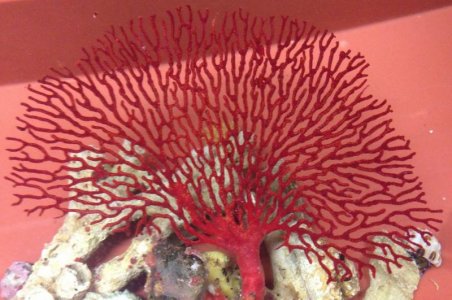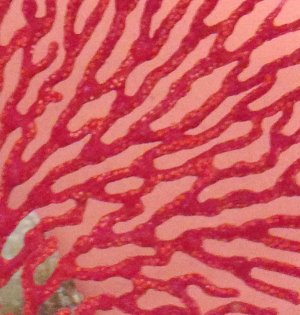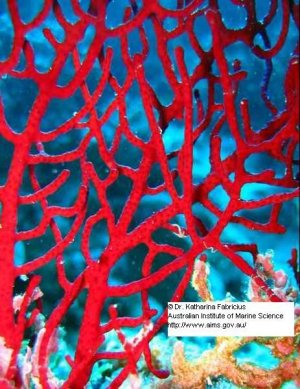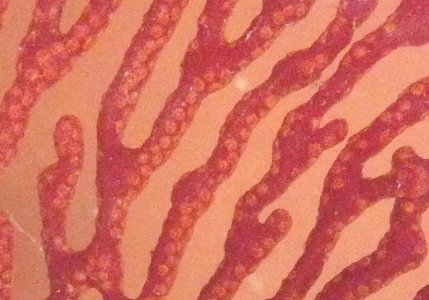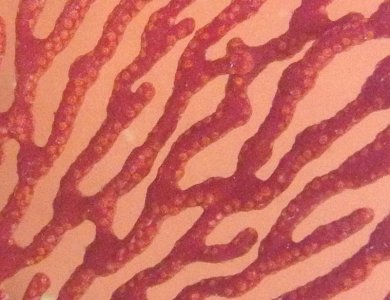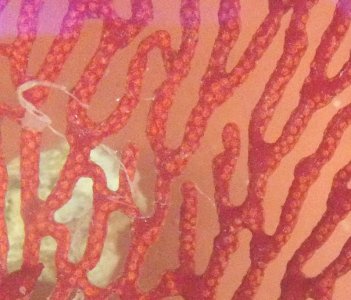You are using an out of date browser. It may not display this or other websites correctly.
You should upgrade or use an alternative browser.
You should upgrade or use an alternative browser.
Red Sea Fan ID
- Thread starter Bela N
- Start date
Bela N
New member
I would have said distichopora or dichotoma, but those are fire coral. Got a pic with polyp extension? And if you have touched it, clearly it is not
I do not thinks I touched it, picked up by the rock.
I thought distichopora had thicker branches, with a well defined central veination?
I have croped a section from another pic which shows the distribution of polyps, light spots. I know it is fuzzy but it may help.
Just took out of the bag from LFS, was hopping shape & branching structure was enough. It it is in a brown plastic holding tank, with a heater & small power head, till tomorrow. I will try to take pics of polyps, if out, before I treat. I Have treated my previous gorgonia & a fire coral (genus Millipora) without ill effects. I treat 6 min. Revive, 6 min CoralRX & 6 min PraziPro. Will this be OK with this type of fire coral ??
Could it be Pacifigorgia?
Attachments
Bela N
New member
NPS for sure...that looks like a fake piece lol
Wouldn't that be a bummer! Sucked in by a fake coral
Last edited:
Bela N
New member
good pic. definitely gorgonia.
I can not tell you what will work for you, but if you have a good system that has worked before, I would be one to say if it aint broke dont fix it....and dont reinvent the wheel
nice piece.
Thanks, that is why I bought it before researching this type of coral. Usually they are half dead or look sickly! I did not want to pass up on what looks to be a relatively intact & healthy coral.
ID makes sense, polyp distribution looks gorgonia like, what ever that means
Do you know the species?
Is there a gorgonia expert in the NPS forum? or is it you?
Reefer54
New member
I am not a gorgonian person, they dont appeal to me as much so I have spent very little time researching but love to learn so will follow......I can tell you it probcably needs to have a constant supply of food if it is going to make it any length of time. it is most likely not photosynthetic and of course will need consistantly optimal parameters.
Based on your pictures and the assumption that it is from the indo pacific region, it might be a Echinogorgia
If it is an Echinogorgia, you might be lucky, because of the pretty large polyps. As soon as we can see the polyps, we can fix the ID more or less.
Cheers Marco
If it is an Echinogorgia, you might be lucky, because of the pretty large polyps. As soon as we can see the polyps, we can fix the ID more or less.
Cheers Marco
You'll be able to tell fairly quickly once you get polyp extension - the echinogorgia has these rich large red polyps.
Borneman's book says gorgonias are single planed and don't mention red as the coloring.
If the branches were thicker I would say its a fire coral - again once you get polyp extension you should know.
the only thing I would throw out is that its a pinnate sea fan - muricea pendula but the growth is far from pinnate - then again all the photos I see of muricea are not pinnate either.
post another photo when you get polyp extension.
Borneman's book says gorgonias are single planed and don't mention red as the coloring.
If the branches were thicker I would say its a fire coral - again once you get polyp extension you should know.
the only thing I would throw out is that its a pinnate sea fan - muricea pendula but the growth is far from pinnate - then again all the photos I see of muricea are not pinnate either.
post another photo when you get polyp extension.
Bela N
New member
You'll be able to tell fairly quickly once you get polyp extension - the echinogorgia has these rich large red polyps.
Borneman's book says gorgonias are single planed and don't mention red as the coloring.
If the branches were thicker I would say its a fire coral - again once you get polyp extension you should know.
the only thing I would throw out is that its a pinnate sea fan - muricea pendula but the growth is far from pinnate - then again all the photos I see of muricea are not pinnate either.
post another photo when you get polyp extension.
The polyps, IMO, are not "rich red". Partially opened polyps (see pics), look more yellowish or cream. I took the pics this afternoon before I treated. Unfortunately, I over dosed Zeo CoralVitalizer & ReeRoids last night thus the water was a bit cloudy this morning. The holding tank, a brown 3 foot window flower planter, without aquarium lights, was under the rooms fluorescent lighting. The combination of rust brown background & room lights makes judging the colours accurately difficult.
Again sorry for the crappy phone pics. I might even take out my good camera, if I have good polyp extension tomorrow. I will post as soon as I have good pics.
Thanks!
Attachments
Hi
Sorry, can't see any polyps extended. But it is certainly not a Muricea which is also called spiny sea rod. If you look at the pictures in the link, you know why. And it is certainly not a fire coral because it has the typical Calyx gorgonia.
It would be really helpful to know where it has been collected from.
Marco
Sorry, can't see any polyps extended. But it is certainly not a Muricea which is also called spiny sea rod. If you look at the pictures in the link, you know why. And it is certainly not a fire coral because it has the typical Calyx gorgonia.
It would be really helpful to know where it has been collected from.
Marco
Bela N
New member
gorgonians are octocorals and the polyps have 8 tentacles
fire corals are hydrocorals and have hairlike structures called dactylozooids - with loaded stinging nematocysts
I really cant tell from the pics
Definitely an octocoral!
How is this for a polyp shot? Will it do? The pic is still a bit fuzzy as I did not turn off the power heads, but better than the phone pic ::lmao::

Coral is in HIGH light . . . . huge PE, does this mean it is photosynthetic?
I would still like to know what species of Gorgonia it is. Any ideas?
Thanks
Bela N
New member
Hi
Still, it would be very helpful to know where it's comming from. Now for sure no Echinogorgia or Muricea. But most likely an azoo because of the white polyps.
M
Emailed source, waiting for reply.
Bela N
New member
. . . . It would be really helpful to know where it has been collected from.
Unfortunately there are 2 possible answers. The LFS says it is probably from Indonesia, though there is a small chance it might be from Hawaii. They display their corals by type and mix various shipments from different sources.
I hope that narrows down the possibilities.
Thanks again.
Similar threads
- Replies
- 3
- Views
- 618

